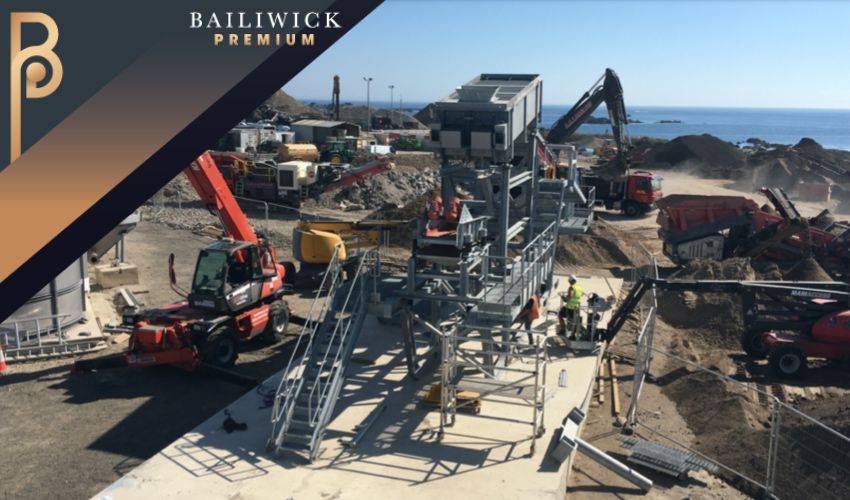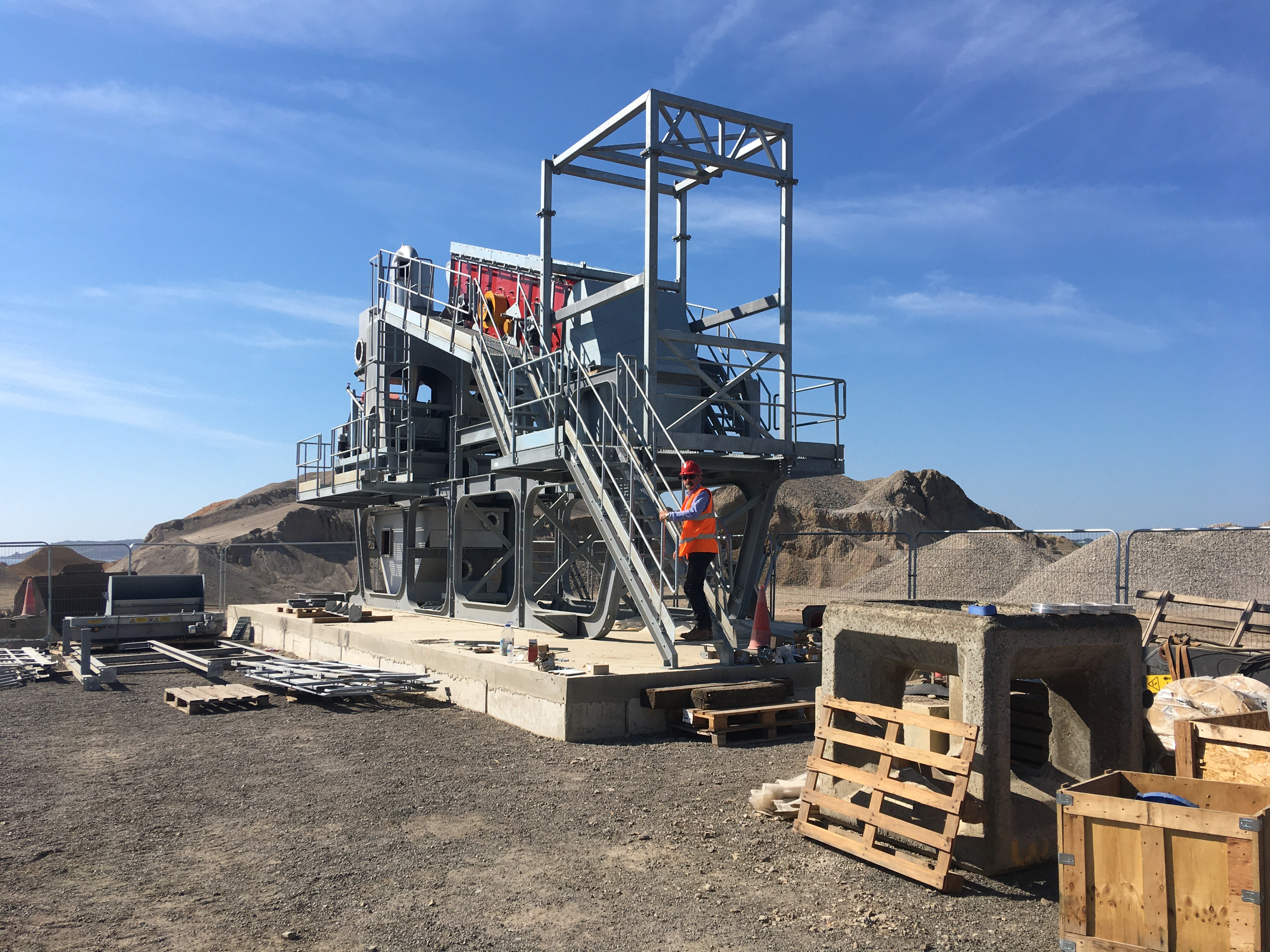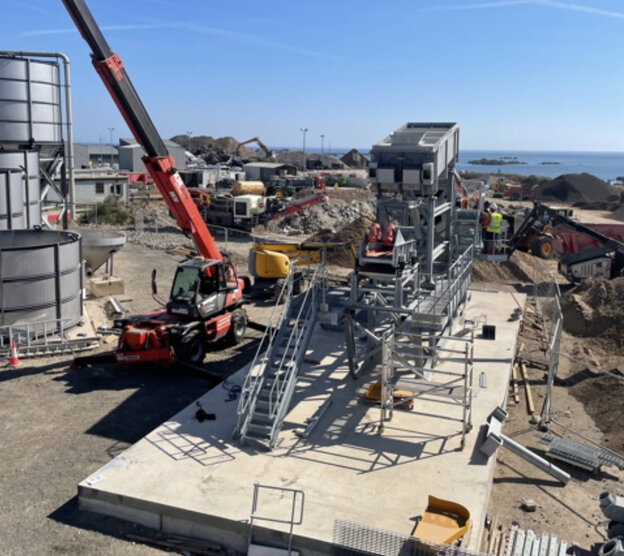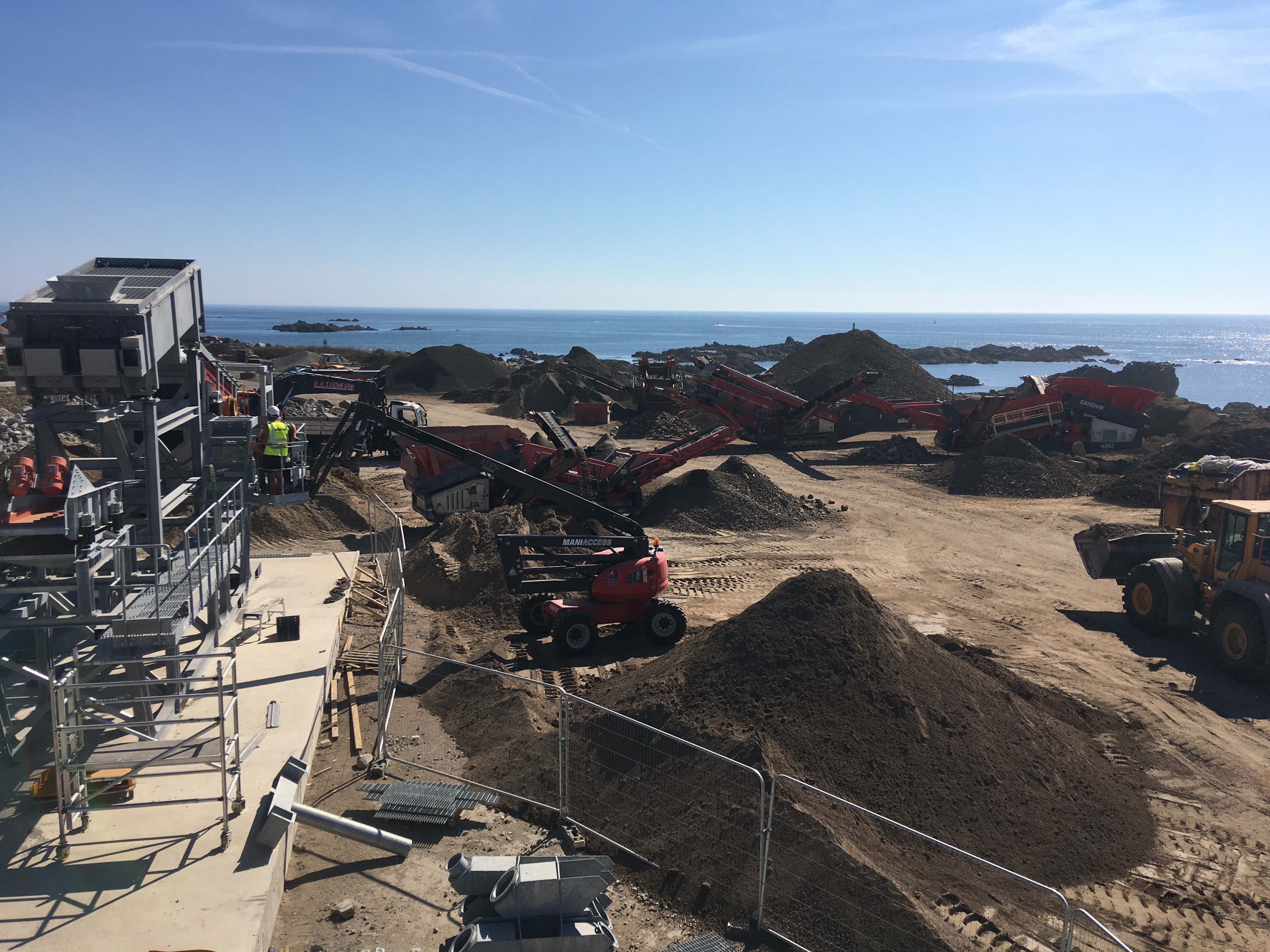


When it comes to resources and waste, the island seems to be at a significant crossroads: our only remaining landfill site is full, our only sand quarry has reached its boundaries of extraction, and one of our two stone quarries wants to controversially expand into a field.
Suddenly, it seems, 9x5 Jersey is discovering the limits of its physical resources.
Fortunately, we’re also getting a lot smarter at recycling, which is not only helping to reduce waste but also demand for extracted ‘virgin’ rock. It also means that Jersey’s ambitious aim of being carbon neutral by 2030 is a little more likely to be achieved.
Currently, three private firms, as well as the Government itself, has a licence to manage waste, and one of those – AAL Recycling – is investing up to £3m to build the island’s first ‘wash plant’ at La Collette.

Pictured: Washing plant project manager John Rogers and AAL Recycling managing director Alan Langlois.
Almost complete, the plant is a fascinating combination of conveyor belts, pumps, vibrating beds, tanks, presses and grading racks - every Lego-builders' dream.
Although existing equipment at AAL can separate building rubble, tarmac, old foundations and other waste into recyclable materials, the new wash plant will produce a far higher quality end-product. It will also be able to work in all weathers and to a far greater capacity.
Former senior civil servant John Rogers is in charge of the wash plant project for AAL.
“From a strategic perspective, for the past 100 years, the island has taken its resources for granted, whether that is sand, granite, the sea or land reclamation,” he said. “It has all been very easy, to dig virgin stuff out and dump it into the sea.
“But that is not sustainable for two reasons: one, the island is drifting south, but also, we are using and abusing the natural materials that we have on-island."

Pictured: The huge recycling washing plant is being built at La Collette, opposite the green waste site.
He continued: “The catalyst for us, and the Government, is that the La Collette reclamation is full, so the next step is either all the material goes into La Gigoulande, Simon Sands or another land reclamation, but all those would have a big challenge in terms of planning permission.
“The urgency last year was how can we keep La Collette still viable. The way we do that is to work with Government. It has increased the cost of tipping here, but Alan [Langlois, owner of AAL] has also committed to building the plant.”
“What it does, compared to what Alan’s normal recycling processes, is that it completely deconstructs the cake, as it were.
If you add water to a cake, it will break down and, in our case, we can deconstruct inert waste back to its individual ingredients, so sand, gravel, small chippings, bigger chippings, and stone," Mr Rogers continued.

Pictured: One of the grading machines in the final stages of construction.
“By doing that, you have higher quality and more consistent materials, which you can sell back into the island."
The simple process is that waste comes in – perhaps rubble from a knocked down building or sections of old road – and it goes through a series of processes, including washing, grading, pressing and spinning, to separate the material into its component parts.
These include different sizes of stone, gravel, grit, and sand. Once all the large particles have been extracted – and conveyors drop them into neatly formed piles in their own bays – the finer particulates are then squeezed through a press to remove the last vestiges of goodness before a final ‘cake’ drops out from between two of the 170 press plates.

Pictured: A view of the existing AAL recycling operation from the top of one of the new washing plant grading machines.
“This is, in theory, the ‘waste’ at the end of the process but we don’t think it is that at all,” said Mr Rogers. “If this is blended with compost, which is produced next door at the green waste site, it will produce a high quality topsoil.
“Worst-case scenario, this is a by-product that may have to go to reclamation, but we’re not planning on it.”
Mr Rogers described it as "perfect upcycling".
"We are also running the plant off electricity, which is derived from the energy-from-waste plant, so comes from the burning of waste," he continued.
“It means there is a neat circular economy, and the plant will be the first pure-electric waste plant in the British Isles.”
Mr Langlois began his business 29 years ago and has had a recycling contract with the States – including handling all glass – for the last 16 of those.
“We started recycling 16,000 tonnes per annum and we’re now doing more than 100,000 tonnes,” he said.
“We take demolition material, waste soils, sands – anything that comes off a construction site – and we recycle it."
Pictured: The wash plant at La Collette. The far left section is the 22m press, which washes and squeezes the smallest sized particles.
“The objective has always been to save material from going into landfill; however, there are no laws stopping people from tipping it over the head [at La Collette, which is managed by the Government] but we have always tried to make it cheaper to tip here and encourage recycling."
Currently – even before the new wash plant is up and running, which it should be by the end of the year – 97.3% of waste that arrives at the AAL gate is recycled.
While that rate can hardly get any higher, Mr Langlois and Mr Rogers are confident that the volume of materials going in and out will increase as will its quality and the ability the extract more of materials in high demand, such as 10mm chippings.
The machine will also extract greater quantities of sand, which will be of a higher quality once washed. AAL already create sand from breaking up our waste glass and it intends to do a lot more of that now that the reclamation site is full.
Previously, the glass was crushed and used as a filtration lining around the site while it was filled up with waste but that is no longer an option. Already sand recycled by AAL is being used in concrete production, including by the company itself.
Pictured: The large tanks store water, which is recycled around the plant, and silt, from which grit and other recyclable materials are extracted.
Mr Langlois’s team began to make large ‘Kelly’ concrete blocks last year to create bay dividers for the new wash plant but they proved so popular among customers that the company bought more moulds and increased production.
Mr Langlois and Mr Rogers expect that they will be able to produce commercial quantities of ‘non-structural’ concrete from recycled aggregate and sand once the wash plant is operational.
“Non-structural concrete is probably a third of the local market but, currently, it is made using virgin components, including Jersey’s lovely pink granite, to make it, which doesn’t make much sense,” said Mr Rogers. “The carbon that is wasted and the energy required is ludicrous.”
AAL is also confident that it can make commercial quantities of sand but until the plant is up and running, it doesn’t know how much.
With the closure of Simon Sands envisaged in the bridging Island Plan, albeit at the end of 2023 rather than now, the Government is confident that the 55-60,000 tonnes dug in St. Ouen’s Bay each year can be met by a mixture of AAL’s washing, Ronez making sand from rock, and some importation.
But for now, the primary focus of Mr Langlois, Mr Rogers and AAL is to get their new wash plant up and running. Initially, they hope to process and sell 4,000 tonnes of recycled materials every week.
Currently selling 2,700 tonnes a week using the existing mobile graders, their aim is to get up to 5,000 tonnes a week.
That’s 5,000 tonnes of waste that doesn’t get wasted; and 5,000 tonnes of materials that don’t have to imported or dug out the ground.
The plant also recycles all the water it uses and it even uses less water when it rains.
Pictured: An existing grading machine at AAL Recycling, which can only operate effectively on dry days, unlike the wash plant.
Normally, when the heaven’s open, the current grading equipment grinds to a halt because the material all clumps together but with the washing plant, rain becomes a virtue.
Mr Langlois said: “Going forward, we will be moving to a completely new level with quality, because it will all be washed. Effectively, it will be on a par with materials extracted from quarries.
“At the moment, lots of materials are coming in from block buildings and we also take all the tarmac off the roads. People drop stuff here every day, and within a couple of hours, it is back into a product and being sold.
“That is going to reach a whole new level within a few months. We’re really excited by this investment in Jersey’s future; it’s something that I passionately believe in.”
Comments
Comments on this story express the views of the commentator only, not Bailiwick Publishing. We are unable to guarantee the accuracy of any of those comments.